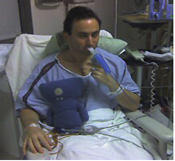“How To Use An Incentive Spirometer?” asks Laura Lee
Written By: Adam Pick, Patient Advocate, Author & Website Founder
Page Last Updated: May 12, 2025
Laura Lee is getting ready for her valve surgery. In anticipation of her recovery, she asked me, “Would you please tell me how to use the incentive spirometer so I can start practicing? Thanks for everything! Laura Lee”
To help Laura Lee, I just found this instructional video on how to use an incentive spirometer from Keck Medicine of USC in Los Angeles, California. Fyi, I had my double heart valve surgery at USC nearly 20 years ago.
I was also able to find some helpful instructions on how to use the incentive spirometer from the Cleveland Clinic and my own personal experience:
- Place the mouthpiece in your mouth with your lips tightly sealed around it. Do not let your tongue block the mouthpiece.
- Inhale (breathe in) slowly and deeply through the mouthpiece to raise the indicator. Try to make the indicator rise up to the level of the target pointer. This is the goal that you need to reach.
- Note the highest level that the indicator has reached.
- When you cannot inhale any longer, remove the mouthpiece and hold your breath for at least three seconds.
- Exhale normally.
- Repeat these steps 5 to 10 times every hour when awake, or as often as caregivers tell you to.
- After each session, try to cough out the sputum (mucus) from your lungs. This is done by inhaling deeply and pushing the air out of your lungs with a deep, strong cough.

To achieve the key benefits of using the incentive spirometer and avoid fluid in your lungs, please remember to use the device consistently. At the same time, you do not want to enhale too deeply, too quickly or you may experience discomfort and/or pain.
Related Links:
- Incentive Spirometer: Patient Benefits
- Fluid in Lungs After Heart Surgery
- Pleural Effusions: What Should Patients Know?
- Weight Gain After Heart Surgery
I hope this helps Laura Lee and you effectively use an incentive spirometer during your recovery.
Keep on tickin!
Adam
|
George S says on October 10th, 2008 at 4:58 pm |
|
Hi Laura Lee, It is really quite simple and your nurse or respiratory therapist will give you complete instructions and make sure you do it correctly when you are in the hospital. The instructions will vary depending on your size, level of pain post op and other factors. They may or may not have you hold your breath at the end of inhalation. They may start you off at about 3 times your normal breath volume or about 1300 to 1600 milliliters and have you increase the volume after that. Practice by slowly breathing to the 2,000 level without holding your breath at the end. Breathe out normally. |
 |











